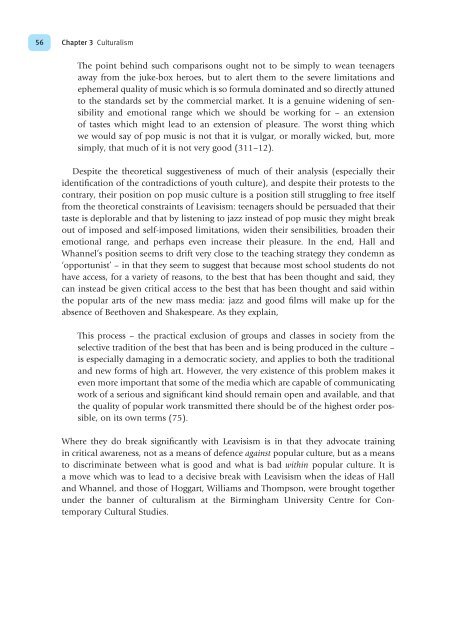Cultural Theory and Popular Culture
Cultural Theory and Popular Culture
Cultural Theory and Popular Culture
Create successful ePaper yourself
Turn your PDF publications into a flip-book with our unique Google optimized e-Paper software.
56<br />
Chapter 3 <strong>Cultural</strong>ism<br />
The point behind such comparisons ought not to be simply to wean teenagers<br />
away from the juke-box heroes, but to alert them to the severe limitations <strong>and</strong><br />
ephemeral quality of music which is so formula dominated <strong>and</strong> so directly attuned<br />
to the st<strong>and</strong>ards set by the commercial market. It is a genuine widening of sensibility<br />
<strong>and</strong> emotional range which we should be working for – an extension<br />
of tastes which might lead to an extension of pleasure. The worst thing which<br />
we would say of pop music is not that it is vulgar, or morally wicked, but, more<br />
simply, that much of it is not very good (311–12).<br />
Despite the theoretical suggestiveness of much of their analysis (especially their<br />
identification of the contradictions of youth culture), <strong>and</strong> despite their protests to the<br />
contrary, their position on pop music culture is a position still struggling to free itself<br />
from the theoretical constraints of Leavisism: teenagers should be persuaded that their<br />
taste is deplorable <strong>and</strong> that by listening to jazz instead of pop music they might break<br />
out of imposed <strong>and</strong> self-imposed limitations, widen their sensibilities, broaden their<br />
emotional range, <strong>and</strong> perhaps even increase their pleasure. In the end, Hall <strong>and</strong><br />
Whannel’s position seems to drift very close to the teaching strategy they condemn as<br />
‘opportunist’ – in that they seem to suggest that because most school students do not<br />
have access, for a variety of reasons, to the best that has been thought <strong>and</strong> said, they<br />
can instead be given critical access to the best that has been thought <strong>and</strong> said within<br />
the popular arts of the new mass media: jazz <strong>and</strong> good films will make up for the<br />
absence of Beethoven <strong>and</strong> Shakespeare. As they explain,<br />
This process – the practical exclusion of groups <strong>and</strong> classes in society from the<br />
selective tradition of the best that has been <strong>and</strong> is being produced in the culture –<br />
is especially damaging in a democratic society, <strong>and</strong> applies to both the traditional<br />
<strong>and</strong> new forms of high art. However, the very existence of this problem makes it<br />
even more important that some of the media which are capable of communicating<br />
work of a serious <strong>and</strong> significant kind should remain open <strong>and</strong> available, <strong>and</strong> that<br />
the quality of popular work transmitted there should be of the highest order possible,<br />
on its own terms (75).<br />
Where they do break significantly with Leavisism is in that they advocate training<br />
in critical awareness, not as a means of defence against popular culture, but as a means<br />
to discriminate between what is good <strong>and</strong> what is bad within popular culture. It is<br />
a move which was to lead to a decisive break with Leavisism when the ideas of Hall<br />
<strong>and</strong> Whannel, <strong>and</strong> those of Hoggart, Williams <strong>and</strong> Thompson, were brought together<br />
under the banner of culturalism at the Birmingham University Centre for Contemporary<br />
<strong>Cultural</strong> Studies.
















